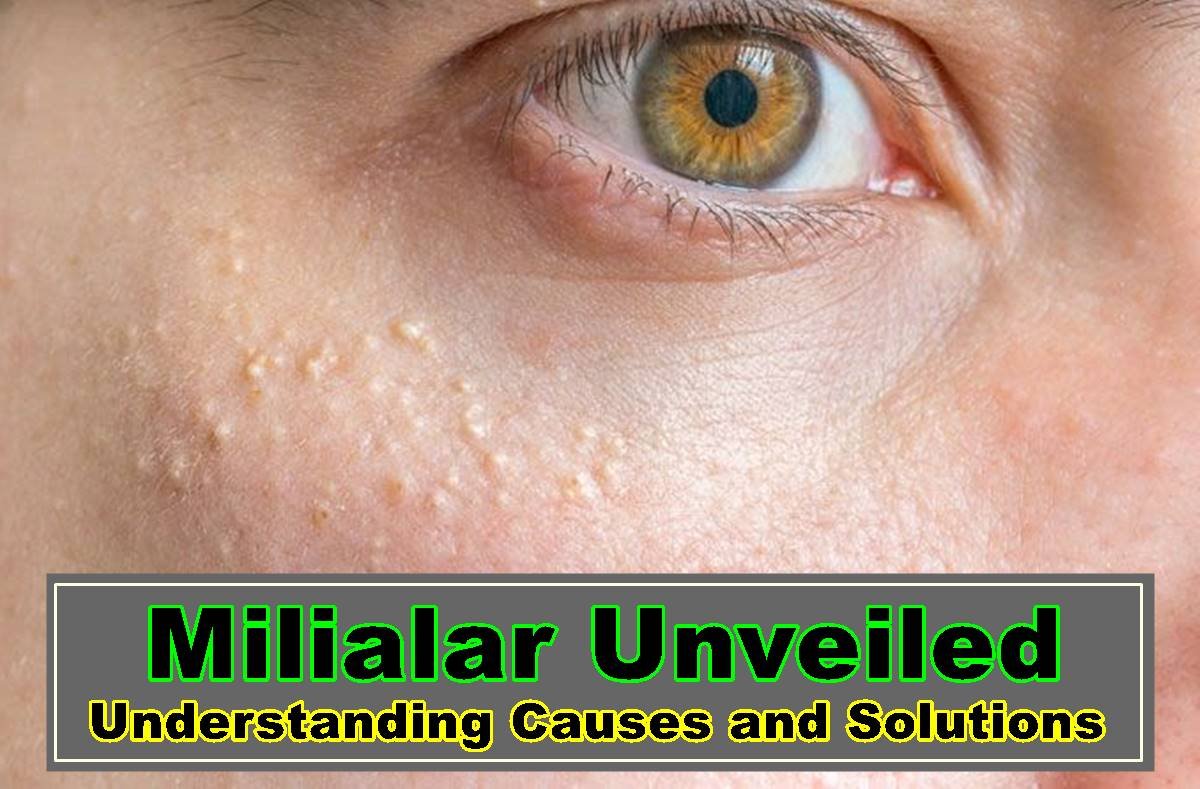Our skin serves as a mirror to our well-being but can sometimes confound us. Milialar, often known as “milk spots” or “oil seeds,” are small yellow or white bumps that can be frustrating. In this article, we delve into the world of Milialar to explore their causes, development, and prevention.
What Are Milialar?
Milialar are tiny cysts that appear as yellow or white lumps on the skin. Unlike acne, they lack pores and can’t be squeezed. These cysts form when dead skin cells become trapped beneath the skin’s surface.
Signs and Symptoms
Milialar typically present as pinhead-sized bumps, and they can be yellow or white, resembling tiny beads. These characteristics are typical of Milialar.
Common Locations
While Milia-lar can appear anywhere on the body, they are most frequently found around the eyes, especially near the cheekbones. They can also be seen on the forehead, around the nose, and, less commonly, on the upper torso.
Potential Issues with Milia-lar
Although Milialar are usually harmless, they can be a cosmetic concern. Prolonged sun exposure or other factors may cause them to persist and affect your skin’s appearance.
What Causes Milialar?
Several factors influence the development of Milia-lar, including:
- Excess Keratin: An excess of keratin, a skin protein, can become trapped under the skin’s surface, leading to Milia formation.
- Damage to Oil Glands and Sweat Ducts: Skin trauma, such as sunburns or excessive sun exposure, can damage oil glands and sweat ducts.
- Cosmetics and Skincare Products: Some skincare products and cosmetics, particularly heavy moisturizers, can clog pores and lead to Milia formation.
- Genetics: A family history of Milialar can increase the likelihood of their occurrence.
Diagnosis of Milialar
Dermatologists diagnose Milia-lar through a comprehensive examination, often using dermatoscopes for a closer look. Your medical history and skincare routine are also taken into account. In cases of uncertainty, a microscopic examination of a small biopsy may be conducted for an accurate diagnosis.
Types of Milialar
Milialar can be categorized into the following types:
- Primary Milia: The most common type, caused by the blockage of sweat ducts by dead skin cells.
- Secondary Milia: Arises from skin injuries or wounds, often due to blisters, burns, or skin treatments.
- Neonatal Milia: Common in newborns and typically resolves on its own within weeks.
- Milia en Plaque: A rare type that covers an irritated and elevated skin area.
Age-Related Factors and Milialar
Age-related changes can influence the development of Milialar. Aging affects skin regeneration, with older skin cells being replaced less efficiently by new ones. Sun exposure and hormonal imbalances during menopause can also impact the development of Milia-lar.
Treatment Options
Treatment methods depend on the size, duration, and location of Milialar:
- Spontaneous Resolution: Milialar often resolve without any specific treatment.
- Cosmetic Dermatology: Dermatologists offer treatments such as cryotherapy, laser therapy, and chemical peels.
- Topical Retinoids: Over-the-counter or prescribed retinoids can help eliminate Milia.
- Home Remedies: Gentle exfoliation and proper skincare can manage Milialar at home.
Prevention and Home Remedies for Milialar
Preventing and taking care of your skin is crucial. Protective measures include using sunscreen and skincare products with salicylic acid, lactic acid, or benzoyl peroxide. In severe cases, a physician may recommend oral antibiotics like amoxicillin or doxycycline.
Conclusion
Milia-lar, often known as “milk spots” or “oil seeds,” are tiny skin cysts that can be perplexing but are usually harmless. Understanding their causes, symptoms, and various treatment options is essential for managing this common skin condition. Whether it’s spontaneous resolution, professional dermatological procedures, or home remedies, there are choices for dealing with milia. Furthermore, being aware of the factors that contribute to milia, including age-related influences and lifestyle factors, is crucial in both prevention and management. By taking steps to protect your skin from excessive sun exposure and considering topical solutions, you can reduce the risk of milia. Overall, this article sheds light on milia and offers valuable insights for individuals looking to maintain healthy, radiant skin.
FAQS
- What is Milialar, and why does it occur?
It is small, harmless cysts that appear as white or yellow bumps on the skin. They occur when dead skin cells get trapped beneath the surface. - Are Milialar dangerous to my skin’s health?
It is generally not dangerous, but they can be a cosmetic concern. They don’t cause harm but can affect your skin’s appearance. - How can I prevent and manage Milialar?
You can prevent Milia-lar by protecting your skin from sun exposure and using suitable skincare products. To manage existing Milia-lar, consult a dermatologist for treatment options. - Can Milialar be treated at home, or do I need professional help?
Mild cases may improve with proper skincare routines, but it’s advisable to seek professional help, especially for persistent or severe Milia-lar. - Are there different types of Milialar, and do they require different treatments?
Yes, there are different types of Milia-lar, but treatment approaches often depend on factors like the type, size, and location of Milia-lar. A dermatologist can recommend the best treatment for your specific case.
